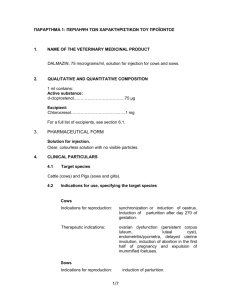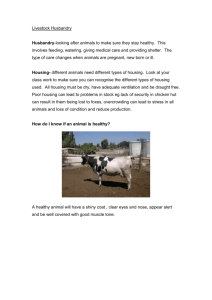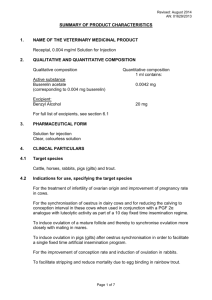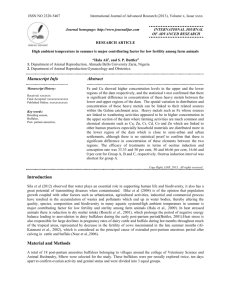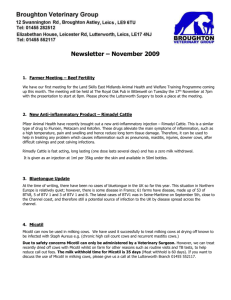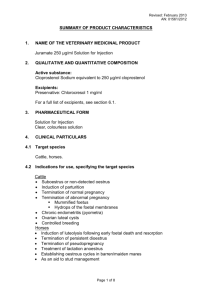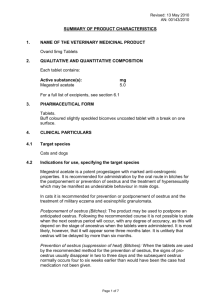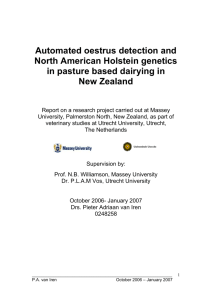March 2012 AN - Veterinary Medicines Directorate
advertisement
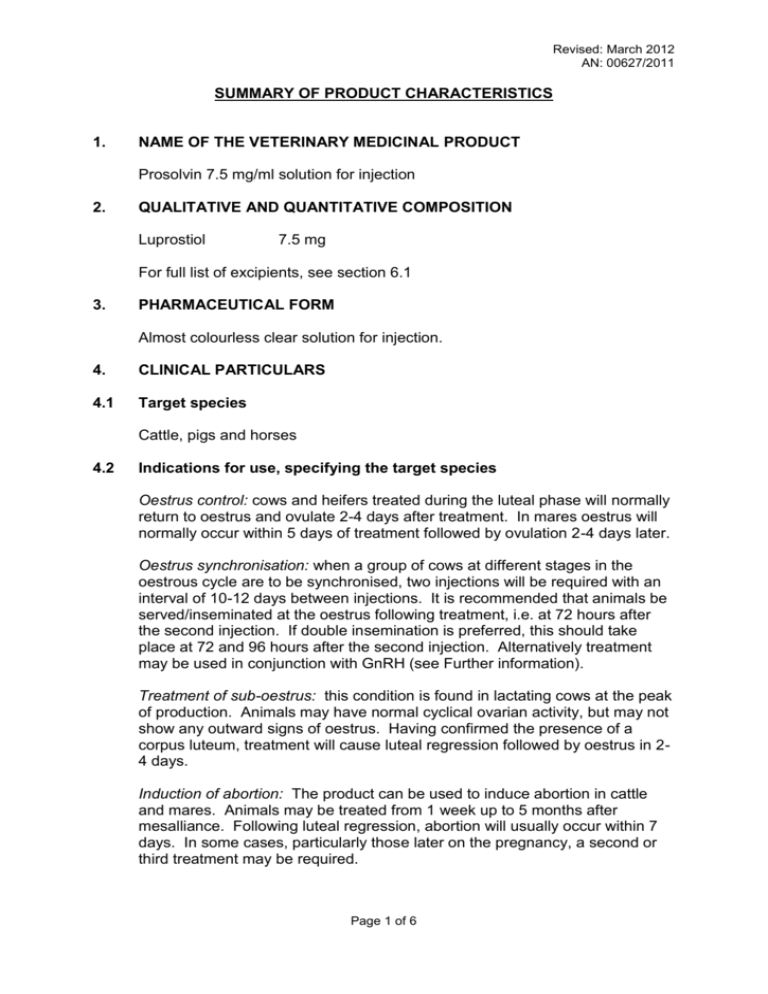
Revised: March 2012 AN: 00627/2011 SUMMARY OF PRODUCT CHARACTERISTICS 1. NAME OF THE VETERINARY MEDICINAL PRODUCT Prosolvin 7.5 mg/ml solution for injection 2. QUALITATIVE AND QUANTITATIVE COMPOSITION Luprostiol 7.5 mg For full list of excipients, see section 6.1 3. PHARMACEUTICAL FORM Almost colourless clear solution for injection. 4. CLINICAL PARTICULARS 4.1 Target species Cattle, pigs and horses 4.2 Indications for use, specifying the target species Oestrus control: cows and heifers treated during the luteal phase will normally return to oestrus and ovulate 2-4 days after treatment. In mares oestrus will normally occur within 5 days of treatment followed by ovulation 2-4 days later. Oestrus synchronisation: when a group of cows at different stages in the oestrous cycle are to be synchronised, two injections will be required with an interval of 10-12 days between injections. It is recommended that animals be served/inseminated at the oestrus following treatment, i.e. at 72 hours after the second injection. If double insemination is preferred, this should take place at 72 and 96 hours after the second injection. Alternatively treatment may be used in conjunction with GnRH (see Further information). Treatment of sub-oestrus: this condition is found in lactating cows at the peak of production. Animals may have normal cyclical ovarian activity, but may not show any outward signs of oestrus. Having confirmed the presence of a corpus luteum, treatment will cause luteal regression followed by oestrus in 24 days. Induction of abortion: The product can be used to induce abortion in cattle and mares. Animals may be treated from 1 week up to 5 months after mesalliance. Following luteal regression, abortion will usually occur within 7 days. In some cases, particularly those later on the pregnancy, a second or third treatment may be required. Page 1 of 6 Revised: March 2012 AN: 00627/2011 Induction of parturition: in cattle, treatment may be used to initiate labour after the 270th day of pregnancy. Calving may be expected within 3 days of treatment. In pigs, the product may be used on or after the 113th day of the gestation period. Parturition will normally follow within 48 hours. It may also be used to induce parturition in the mare. Treatment must occur on or after the 330th day of pregnancy and the mare must show relaxed pelvic ligaments and functional udder with colostrum. Following treatment parturition may be expected within a few hours. Treatment of anoestrus: a persistent corpus luteum, particularly during lactation may result in an anoestral mare. The product may be used to cause luteal regression; oestrus and ovulation will then follow usually within 4-8 days of treatment. Treatment of endometritis or pyometra in cows: The luteolytic effect induces oestrus which will aid the expulsion of uterine discharge. A single injection of 2 ml should be given; intransigent cases may require a repeat treatment after 10-14 days or alternative therapies should be considered. Further information Prosolvin can be used as part of a 10-day GnRH/prostaglandin/GnRH oestrus synchronisation and insemination regime to increase submission rates and significantly reduce the calving to conception interval. The use of GnRH 7 days prior to Prosolvin increases the proportion of cows able to respond to the prostaglandin and co-ordinates a new follicular wave so more cows will ovulate during a shorter time after Prosolvin. A second GnRH treatment after the prostaglandin further tightens synchrony of ovulation in relation to the service time. The Intervet GnRH/prostaglandin/GnRH regime (Intercept™) for breeding dairy cows at a pre-planned time without the need for specific heat detection is summarised below: Day 0 GnRH (2.5 ml) Day 7 Prosolvin (2 ml) Day 9 GnRH (2.5 ml) 54-56 hours post prostaglandin or at AI if sooner Day 10 AI 72 hours post prostaglandin or at observed heat if sooner. When using the Intercept fixed time insemination regime, it is recommended that cows showing signs of oestrus after prostaglandin treatment should be inseminated when observed in oestrus rather than completing the synchronisation programme. Trials have shown that for cows holding to their first service, use of a GnRH/prostaglandin/GnRH regime can improve the calving to conception interval by 11 days when compared to controls. When including all services, the calving to conception interval was shown to be improved by 7 days Page 2 of 6 Revised: March 2012 AN: 00627/2011 4.3 Contra-indications This product should not be given to pregnant animals unless the intention is to produce abortion or parturition. 4.4 Special warning for each target species There is a refractory period of about 4-5 days post ovulation when animals will not respond to treatment. The length of the gestation period in pigs can vary depending on breed. The product should not be given more than 2 days before the expected parturition date. There is a risk of reduced piglet viability if parturition is induced earlier than 48 hours before the predicted farrowing date. Early induction of parturition in cattle may result in a higher than normal incidence of retained foetal membranes. When prostaglandins are used in the treatment of endometritis in cattle, adjunct therapy may be of benefit in certain cases. 4.5 Special precautions for use i. Special precautions for use in animals Intravenous injection is not recommended. ii. Special precautions to be taken by the person administering the medicinal product to the animals Prostaglandins of the F2α type can be absorbed through the skin and may cause bronchospasm or miscarriage. Care should be taken when handling the product to AVOID SELFINJECTION OR SKIN CONTACT. Women of child-bearing age, asthmatics and persons with bronchial or other respiratory problems should avoid contact with, or wear disposable plastic gloves when administering the product. Accidental spillage on the skin should be washed off immediately with soap and water. 4.6 Adverse reactions (frequency and seriousness) Very few adverse reactions have been seen with this product. Sweating and a slight respiratory effect have been reported in a small number of horses but these effects were mild and transient. It is, however, possible for prostaglandins to cause diarrhoea in horses and abdominal discomfort in cattle. 4.7 Use during pregnancy or lactation This product should not be given to pregnant animals unless the intention is to produce abortion or parturition. Page 3 of 6 Revised: March 2012 AN: 00627/2011 4.8 Interaction with other medicinal products and other forms of interaction None known. 4.9 Amounts to be administered and administration route Cows: Heifers: Horses: Pigs: single or repeated injections of 2 ml (15 mg luprostiol) single or repeated injections of 1 ml (7.5 mg luprostiol) single or repeated injections of 1 ml (7.5 mg luprostiol) single injections of 1 ml (7.5 mg luprostiol) The product is administered by deep intramuscular injection. 4.10 Overdose (symptoms, emergency procedures, antidotes), if necessary No specific treatment or antidote recommended. 4.11 Withdrawal periods for the various foodstuffs, including those for which the withdrawal period is zero Cattle: 4 days Milk: 12 hours Pigs – meat: 4 days Not to be used in horses intended for human consumption. Treated horses may never be slaughtered for human consumption. The horse must have been declared as not intended for human consumption under national horse passport legislation. 5. PHARMACOLOGICAL PROPERTIES 5.1 Pharmacodynamic properties Luprostiol is a synthetic prostaglandin F2α and is a luteolytic agent. Provided an active corpus luteum is present, its primary action is to cause luteal regression which will be followed by follicle growth, oestrus and ovulation. ATC Vet code: QG02AD91 5.2 Pharmacokinetic particulars Luprostiol is very quickly absorbed from the injection site in all species. Peak plasma concentrations are generally reached within 17.5, 37.5, 22.5 and 30 min after treatment of cows, horses, goats and sheep, respectively. Luprostiol distributes to kidney, liver, fat, and muscle (ordered by decreasing concentrations). Page 4 of 6 Revised: March 2012 AN: 00627/2011 Within 12 hours, it metabolizes into carboxylic acid of tetranor-luprostiol and its derivates by β-oxidation of the carboxylic acid side chain. The pharmacokinetic profile shows a very rapid fall in concentrations in all target species with half life of 2, 1.1, 1.5, and 1.5 hours in cattle, goats, sheep and mares respectively. Luprostiol does not accumulate in any organ and it is rapidly excreted via urine and feces. 6. PHARMACEUTICAL PARTICULARS 6.1 List of excipients Sodium hydroxide Water for injections Propylene glycol 6.2 Incompatibilities None known but should not be mixed with other products. 6.3 Shelf life Shelf life of the veterinary medicinal product as packaged for sale: 5 years Shelf life after first opening the immediate packaging: 28 days 6.4 Special precautions for storage Do not store above 25°C. Protect from light. Following withdrawal of the first dose, use the product with 28 days. Discard unused material. 6.5 Nature and composition of immediate packaging Clear, Glass Type I (Ph.Eur) vials with halogenobutyl rubber stopper, closed with a colour coded aluminium cap, containing 2 ml, 10 and 20 ml of Prosolvin. Not all presentations may be marketed. 6.6 Special precautions for the disposal of unused veterinary medicinal product or waste materials derived from the use of such products Any unused veterinary medicinal product or waste materials derived from such veterinary medicinal products should be disposed of in accordance with local requirements. Page 5 of 6 Revised: March 2012 AN: 00627/2011 7. MARKETING AUTHORISATION HOLDER Virbac S.A., 1ère Avenue, 2065 m – LID 06516 Carros Cedex France 8. MARKETING AUTHORISATION NUMBER Vm 05653/4158 9. DATE OF FIRST AUTHORISATION/ RENEWAL OF THE AUTHORISATION Date of first authorisation: 31 March 1995 Date of renewal: 31 March 2005 Date of renewal indefinitely from 31 March 2010 10. DATE OF REVISION OF TEXT Date: March 2012 Page 6 of 6

